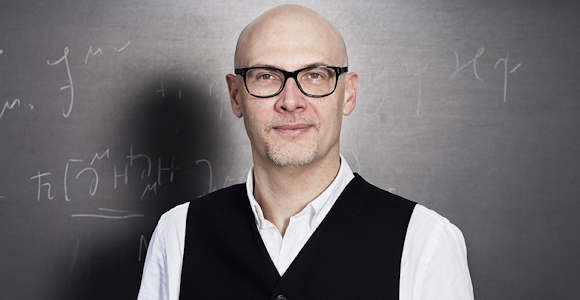
Music and Physics Have Much in Common
Physicist Francesco Sannino almost always works with classical music in the background – often Bach, Mozart, Haydn, Rachmaninov, or Shostakovich. The structure and rhythm of the music help him think.
Why did you become a researcher?
Since my teens I was fascinated by science and science fiction. I chose the scientist’s path after watching short cartoons on quantum mechanics in Quark, the science outreach program by Piero Angela on RAI, which is Italy’s public broadcaster and the equivalent of DR in Denmark.
I am driven by the belief that a few deep principles can illuminate an astonishing range of phenomena, from quarks to galaxies. Quantum field theory combines elegance with resistance to easy answers. I enjoy the path from a messy line on a whiteboard to a clear result, and the feeling that careful reasoning can move the frontier forward even a millimetre. Mentors and students also keep me in research, because science is a communal craft where good questions lead the way. I feel a responsibility that comes with public trust in science, to push knowledge forward, keep it open and reproducible, and hand sharper tools to the next generation.
What else did you dream of becoming?
A composer and pianist. Music and physics share a grammar of patterns, symmetries, tension and resolution. In composition you balance simplicity with surprise, and in theory you balance minimal principles with rich consequences. I still play and sketch musical ideas when I can, since some problems become clearer at the keyboard than at the blackboard. The discipline of daily practice in music shaped my approach to research, which is patient, iterative, and always listening for the underlying theme. As a teenager I also imagined becoming a war journalist.

About Francesco Sannino
Francesco Sannino is a theoretical physicist, professor and director of Quantum Field Theory Center at Department of Mathematics and Computer Science. Before coming to SDU, he studied and worked at University of Naples, Syracuse University, Yale University, CERN and the Niels Bohr Institute of the University of Copenhagen. He is the founder of the Center for Particle Physics Phenomenology (CP3-Origins) and the founder of the Danish IAS as well as Professor of Theoretical Physics at the Federico II University in Italy.
Here is his research profile.
What question would you most like to find the answer to?
Can we build a unified and reliable framework to solve interacting quantum fields across scales, one that is conceptually clean, computationally efficient, and systematically improvable? Such a framework would bring together semiclassics, large charge methods, lattice calculations, and conformal or bootstrapped ideas. The payoff would be immense, with sharper predictions for the Standard Model and beyond, new windows on the early universe, and principled links to quantum black hole physics. I want a toolbox that turns intractable into tractable with quantified uncertainty.
How do you hope others can benefit from your research?
History shows that understanding fundamentals unlocks technology. GPS works because we understand gravitational dynamics and include relativistic corrections. Modern electricity and communications followed from Maxwell’s unification of electromagnetism. By deepening our grasp of quantum fields and gravity, including insights that touch quantum black hole physics, we can enable better materials, detectors, algorithms, and modelling frameworks. I have also applied theoretical physics to epidemiology, where our approaches informed pandemic modelling and had impact for society. Beyond applications, I focus on training students in clear reasoning and in open and reproducible science, skills that flow into industry, policy, and education.
What do you have in your office that most other people do not?
A large whiteboard, even though I still prefer a chalk blackboard, and shelves of physics books I have collected over the years, full of notes and bookmarks. I almost always work to classical music, from Bach and Mozart to Haydn, Rachmaninoff, and often Shostakovich, since structure and rhythm help me think. There is a CP3-Origins mug with Feynman diagrams that makes me smile. At home I keep a manga painting by my daughter, which is the best motivation. I do not have a Quantum Kate poster yet, but perhaps I should.
Who do you admire?
Emmy Noether for revealing how symmetry underpins conservation laws with unmatched clarity.
Niels Bohr for intellectual courage and for connecting ideas across scales.
Enrico Fermi for judgment, simplicity, and the ability to reach the essence of a problem.
Richard Feynman for curiosity, playfulness, and the gift of explaining complexity without condescension.
I also admire my students and collaborators, because science advances when many minds discuss together.
What do you do when you are not researching?
I play the piano and sometimes compose short sketches, which clears my head and sharpens focus. I enjoy classical concerts and contemporary art because both challenge how we perceive structure and meaning. I take long walks where many ideas untangle themselves. I train at the gym and, when I can, I take boxing classes. I value time with family and friends, since good conversations are as important for science as good equations.
- Read also Q&A with physicist Astrid Eichhorn, who has a particular interest in black holes (in Danish)
- Read also Q&A with mathematician David Kyed: What We Prove Mathematically Today Will be Just as True in 100 Years
- Read also Q&A with physicist Martin S. Sloth, who is captivated by the Universe's most fundamental questions